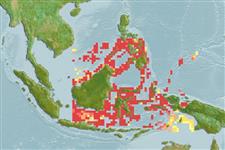Common names from other countries
Classification / Names / Names
Populärnamn | synonymer | Catalog of Fishes (gen., sp.) | ITIS | CoL | WoRMS
Environment: milieu / climate zone / depth range / distribution range
Ekologi
. Tropical; 23°C - 30°C (Ref. 102835); 13°N - 9°S, 109°E - 139°E (Ref. 106696)
Western Central Pacific: Restricted in the tropical western Pacific. From Sabah, Malaysia to Palau, north to Philippines and south to Indonesia.
Length at first maturity / Size / Vikt / Age
Maturity: Lm ? range ? - ? cm Max length : 41.1 cm SHL hane/ej könsbestämd; (Ref. 117184); common length : 20.0 cm SHL hane/ej könsbestämd; (Ref. 348)
Its shell is thinner and smoother than that of H. hippopus, usually devoid of pigmentation, and more semi-circular in profile. The mantle is similar to that of H. hippopus (Rosewater, 1982), except that prominent papillae line the margins of the incurrent siphon.
Collected for food and shell (Ref. 348). Found in shallow waters. Young specimens often byssally attached to coral heads, mature specimens lack a byssus and lay unattached on the substrate (Ref. 348).
Life cycle and mating behavior
Könsmognad | Reproduktion | Lek | Ägg | Fecundity | Larver
Broadcast spawners. Life cycle: Embryos develop into free-swimming trocophore larvae, succeeded by the bivalve veliger, resembling a miniature clam (Ref. 833).
Poutiers, J.M. 1998. (Ref. 348)
IUCN Red List Status (Ref. 130435)
CITES status (Ref. 108899)
Not Evaluated
Threat to humans
Harmless
Human uses
Fiskeri: kommersiell
FAO - Vattenbruk: produktion; | FishSource | Sea Around Us
Verktyg
Internet-källor
Estimates based on models
Resiliens
Låg, lägsta populationsfördubblingstid 4,5-14 år (K=0.13).
Vulnerability
Low to moderate vulnerability (30 of 100).
Price category
Unknown.
